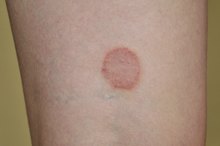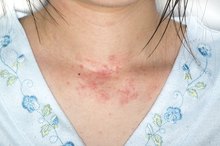What does fact checked mean?
At Healthfully, we strive to deliver objective content that is accurate and up-to-date. Our team periodically reviews articles in order to ensure content quality. The sources cited below consist of evidence from peer-reviewed journals, prominent medical organizations, academic associations, and government data.
The information contained on this site is for informational purposes only, and should not be used as a substitute for the advice of a professional health care provider. Please check with the appropriate physician regarding health questions and concerns. Although we strive to deliver accurate and up-to-date information, no guarantee to that effect is made.
How to Get Rid of Folliculitis Scars
You may have experienced folliculitis if you've ever noticed tender bumps on the skin, particularly after shaving or waxing. Folliculitis is an infection of the hair follicle or root that can occur anywhere on your body. Severe infections can lead to permanent hair loss and scarring, or dark, hyperpigmented spots on the skin 2. Folliculitis usually stems from a bacterial or fungal infection and may cause small, pus-filled bumps that can be itchy and painful. Consult your doctor for treatment of the infection and skin scarring.
Consult your doctor or dermatologist about treatment for folliculitis. Your doctor may prescribe an oral or topical skin antibiotic. Follow the exact dosage for your antibiotics and continue the medication until it is completed. Avoid shaving, scrubbing or scratching the infected area until it heals. If you must shave, use a clean, disinfected razor blade on the area of infection and do not use it elsewhere on your face or body.
What Is the Difference Between Cellulitis & Mrsa?
Learn More
Apply a wet compress soaked in a mixture of white vinegar and water to the infected area. Other alternative treatments include applying a wet compress with a few drops of tea tree oil or eucalyptus oil. The oils have anti-bacterial and anti-fungal properties to treat minor superficial infections on the skin. Consult your doctor before trying these remedies.
Treat folliculitis scars with skin chemical peels and lightening creams. Your dermatologist can prescribe these treatments. A chemical peel can be applied in a doctor's office once or twice a month. Prescription lightening creams for hyperpigmentation or darkened areas are applied as spot treatment on the skin to reduce the appearance of scarring.
What Is the Difference Between Cellulitis & Mrsa?
Learn More
Exfoliate healed folliculitis scars to even out skin discoloration and pitting. Try gentle homemade scrubs containing baking soda or finely ground salt. Add a teaspoon of baking soda or salt to your regular cleanser and gently massage into the skin to exfoliate. Continue exfoliating regularly over several months to see gradual improvement.
Tips
Prevent folliculitis by shaving in the same direction as the hair growth, using shaving cream and warm water to soften the hair before shaving and astringent toners or aftershave after shaving and waxing. It is also important to gently exfoliate after waxing to avoid dead-skin buildup in the hair follicles.
Warnings
Folliculitis scars should not be treated until the infection has completely healed. Do not apply scar-treatment cream on broken skin or infected skin bumps. This can cause skin burning and inflammation. Apply skin-lightening creams as prescribed as they can cause skin irritation and redness. It is important to wear sunscreen on all exposed skin, particularly when using these medicated creams.
Related Articles
References
- Guo EL, et al. (2017). Diet and hair loss: Effects of nutrient deficiency and supplement use. DOI:
- Hair loss (alopecia). (n.d.).
- Mayo Clinic Staff. (2017). Folliculitis.
- Ngan V. (2003). Folliculitis decalvans.
- American Academy of Dermatology Association. Acne-like breakouts could be folliculitis.
- U.S. National Library of Medicine. MedlinePlus. Folliculitis. Reviewed October 8, 2018.
- Merck Manual Professional Version. Folliculitis, Revised September 2019.
- American Osteopathic College of Dermatology. Folliculitis.
- Fearfield, L.; Rowe, A.; Francis, N.; et al. "Itchy folliculitis and human immunodeficiency virus infection: clinicopathological and immunological features, pathogenesis and treatment." British Journal of Dermatology. 2009; 141(1):3–11.
- U.S. Department of Veteran Affairs. "Dermatologic Conditions: Primary Care of Veterans with HIV - Organ Systems and Metabolic." October 8, 2011; Washington, D.C.
Writer Bio
Noreen Kassem is a hospital doctor and a medical writer. Her articles have been featured in "Women's Health," "Nutrition News," "Check Up" and "Alive Magazine." Kassem also covers travel, books, fitness, nutrition, cooking and green living.








